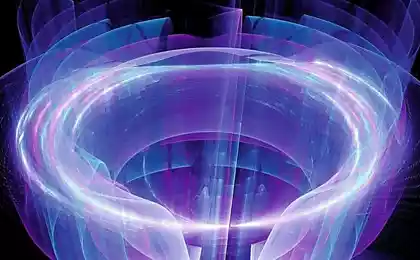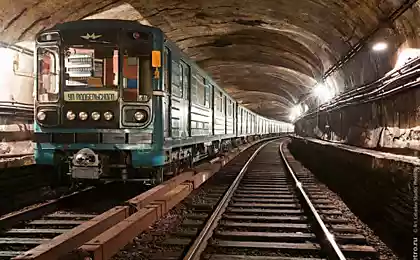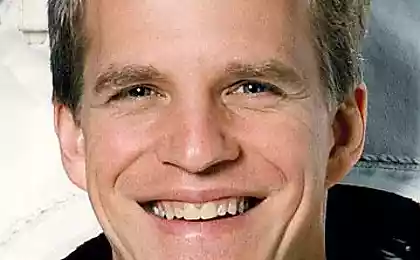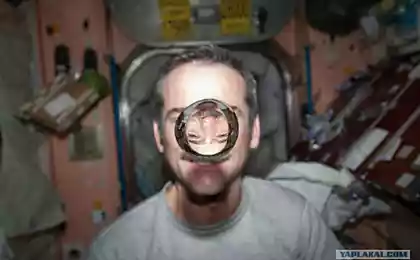1215
How to see the ISS tonight

Many believe that the International Space Station (ISS) is flying somewhere very far away, and to see it (and even more so to photograph) need special equipment. However, this is not so. ISS every day several times sweeps over our heads and see it no more difficult than a regular passenger airplane. You just need to know when and where to look. As the brightness of the ISS can compete even with Jupiter and Venus, and its rapid motion across the sky more attracts attention. In this article I want to tell you how and when you can see the ISS tonight in Moscow , tell me how to find out the time of flight of the ISS to any other place, as well as touch on the subject of photos and video of the ISS.
What do I need to observe?
No telescopes and binoculars will help us even more harm. The fact that the ISS is moving very quickly to catch and track the optical device with a large increase is difficult. Here is SIFCO gives some idea of its speed.

And we will need a clear sky (tonight it's all right):
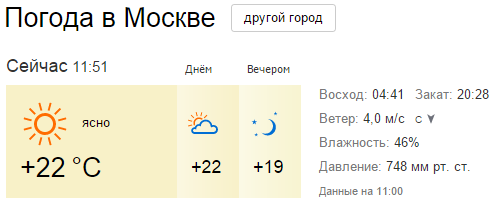
... And an outdoor area with a good view to the south-west, south and south-east (eg supermarket car park, sports ground, the roof of the building, etc.). The proximity of the bright lights will not prevent us, as the ISS is a very bright object. If too lazy to go out, you can get a balcony or window overlooking the south side.
We also need the clock synchronized with the exact time and compass (in case you do not know even approximately the directions on the side of the light at the selected point for observation).
When and where to look?
ISS makes one turn in about half an hour. This means that if the Earth did not rotate, we would see the ISS pass by the same path every half hour. Since the Earth is still rotating, the "footprint" of the ISS to the Earth's surface with each revolution shifted to the west. In addition, the ISS can be seen only when she is illuminated by the sun, while at the location of the observer was dark (you can manage to рассмотреть ISS even day , but it's harder). To calculate the current ISS visible spans over Moscow, I used the online service heavens-above.com (residents of other cities can easily get there visibility of ISS alone). The most favorable for observation flight will Today about 22:47
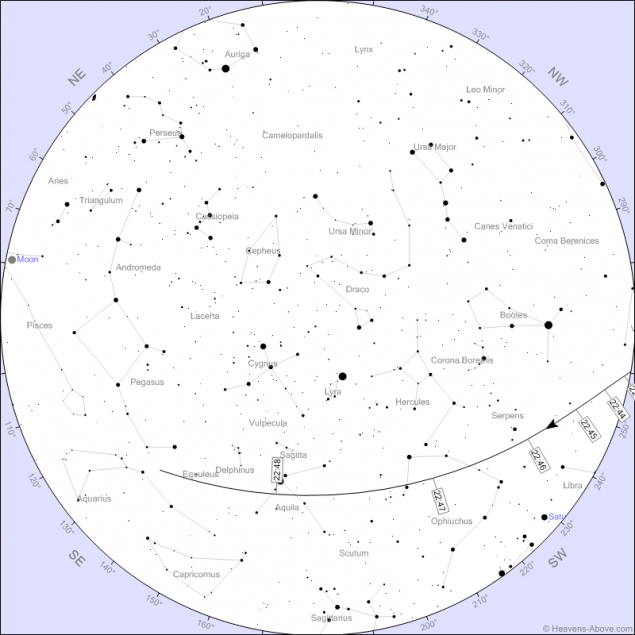
Stars on the map, we do not particularly help in the city because they can be seen not so good. Simply navigate to the cardinal points using the compass. If you do not have a compass, look for the direction where the sunset is burning, there is north-west.
ISS will rise in the 22:42:30 , but to begin to look for her at this time yet. Near the horizon it is still not bright, besides the review may hinder trees, buildings and haze. It is better to wait when it will rise by at least 10 degrees above the horizon. It will happen in the 22:44:38 , the ISS will be somewhere between the west and south-west. You'll notice a dim flicker-free star that moves slowly to the left and upward. The asterisk - ISS flying somewhere over France at a distance of one and a half thousand kilometers. Do not hurry to get upset if you can not notice it at the moment - you could prevent light clouds on the horizon or you miscalculated a little direction. The asterisk will move faster, inflame brighter and a minute later it will find it much easier. The station reaches a maximum height of 40 degrees in the 22:47:43 , is practically on the south azimuth. At this point, the ISS will be just below the star Altair, in brightness compared with Venus and the angular velocity - a jet. Its distance is about 600 km. Then, the ISS will decrease, shifting to the east, and 22:48:52 will enter the Earth's shadow. Because of the brightness of the station's atmosphere falls instantly. It will gradually fade over a dozen seconds. Particularly attentive observers will notice that before go out, the ISS will turn red. After all, at this time the astronauts on board will see the sunset, and at sunset the sun's rays redden. When the station finally disappears from view, look to the east and as a bonus you will see the moon rising.
Note: The above times will be true with the second accuracy for an observer on the Red Square. If you're away from the center, there will be differences in a few seconds. For example Reutov maximum height is reached 2 seconds later. Log in shadow, of course, will happen at the same time for all observers. I>
Another less convenient for observation flight revolution will happen before, 21:11

How to photograph the ISS or videotape?
If you are going to watch the ISS for the first time, I recommend is not to be distracted by the photo. It is better to look at the eyes, make a picture of the brightness and speed. Next time, например tomorrow , you can already go out with a camera. Set the shutter speed in 10-30 seconds. Adjust the aperture and sensitivity so as not to overexposure sky, but at the same time so you can see the stars. Set the camera on a tripod and aim it on the part of the sky which is expected to span. A few minutes earlier, you can take a test shot to, guided by the stars, make sure that the frame gets the right part of the sky. As a result, you can get a shot like this (photo not mine, found in Google Images).

If the flight is expected to close by the moon, it is possible to catch an interesting shot. I like that's what happened:

In dynamics, it looked like this (photographed on a compact camera Panasonic HDC-SD90).
What about the transit of the Moon and the Sun. shown at the beginning of the article?
Recently, news portals flown новость the fact that NASA has published a unique pictures of the ISS on the background of the moon. Even at this Giktayms wrote marks < / a>. In fact, in the picture is not unusual, this can be seen by searching for the keyword & quot; iss transit & quot; in Google Images. I managed the first attempt to make such a photo and video equipment having a modest (the same that I used in the article Watch Solar Eclipse together ) :
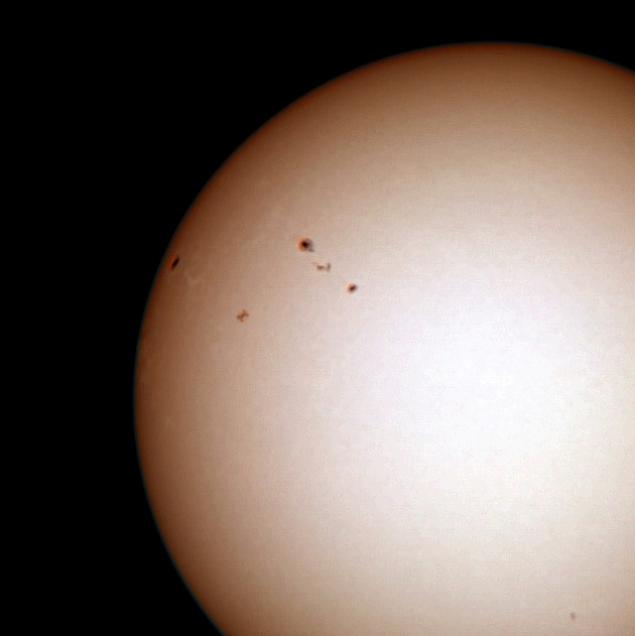
Video is best viewed in full-screen mode:
The main problem here is that the shadow (or rather the penumbra) cast by the ISS from the sun or the moon has a size of only a few kilometers. The randomly taken place this phenomenon is extremely rare, so you have to wait for the right moment to sit in the car and drive a few tens of kilometers. To find out when and where to go, you can use the service calsky.com . There you can get a map showing where the ISS will run a shadow over the next couple of days. Here's an example fragment map next transits of the Moon.

Conclusion
I hope that through this article, many readers will go outside tonight and look at the sky. I propose to share experiences in the comments! You will try today to see the ISS? I'm from Moscow or the Moscow region, will try to look. I'm from out of town, to calculate the time of flight of yourself and see. will not look - in my town today, bad weather or not visible span. I will not look - I'm not interested, no time, etc. Voted 430 people. Abstain 114 people. Only registered users can participate in the survey. Sign , please.
Source: geektimes.ru/post/246018/
